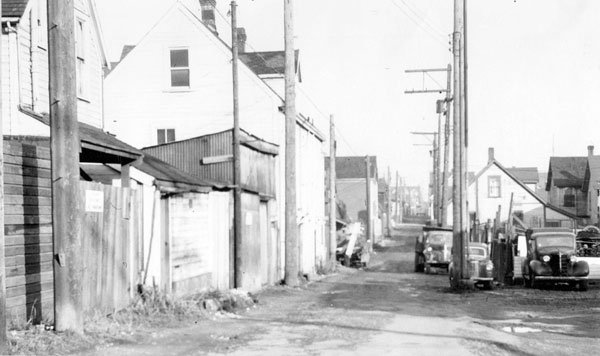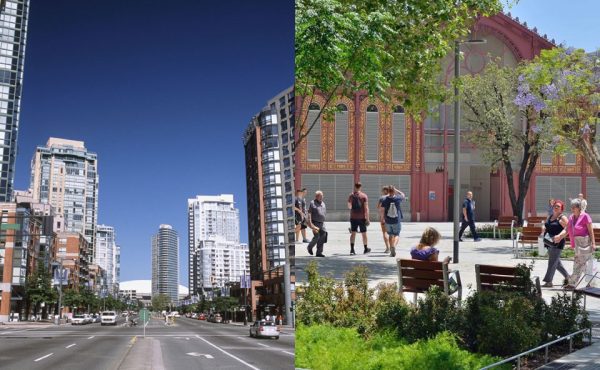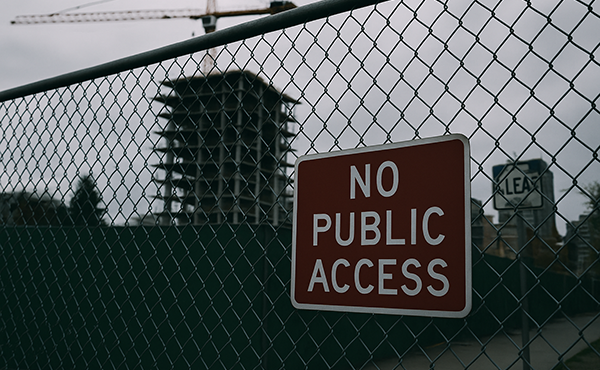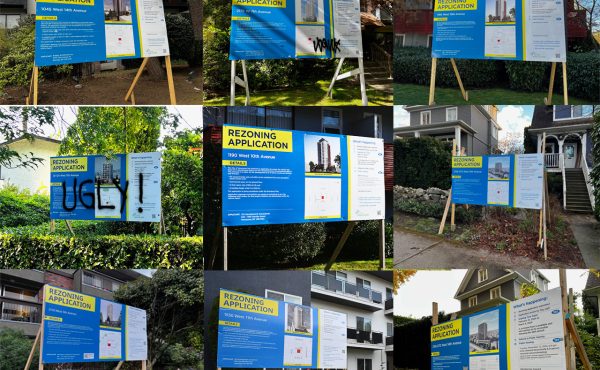
The second part of this three-part series described the rise and reaction against the Vancouver Transportation Study (VTS), proposed during 1967. A process that ultimately led to the ‘saving’ of Chinatown and Strathcona, but still left the fate of Hogan’s Alley uncertain.
While researching through various libraries and the City archives in the hopes of finding information as to the reasons behind the relocation of the Georgia Viaduct, the facts about clearance of Hogan’s Alley and the (dis)placement of the residents were minimal. It forces one to ask where the accountability lies for projects of this nature.
To a degree, urban planning strategies need to be measured qualitatively, not quantitatively. Determining the efficiency of land, or of a community, should not solely be defined through statistics or fiscal values – but through cultural needs and the way neighbourhoods interact with their environment. But, unfortunately for Hogan’s Alley, it was destroyed for the construction of the new Georgia Street Viaduct and the first—and last—Black community in Vancouver became victim to “Slum Clearance”. The measures taken by the City towards the displaced residents along Hogan’s Alley, such as where they ended up living or if they were compensated, is a mystery.
As seen from the examples stated above, Urban Renewal or “Slum Clearance”, was socially and racially motivated. It is common knowledge that immigrant neighbourhoods, post WWII, consisted dominant of lower income residents and that these areas were considered “blight”. Post-industrialization saw the decentralization of residents from the Central Business District (CBD) as the land in or around it increased in value. As factories and industries moved to the suburbs as the land and taxes were cheaper, lower income residents followed.
To understand Urban Renewal, it is necessary to comprehend how an area is deemed suitable for renewal. As expressed by Jane Jacobs, “the simple needs of automobiles are more easily understood and satisfied than the complex needs of cities, and a growing number of planners and designers have come to believe that if they can only solve the problems of traffic, they will thereby have solved the major problem of cities.”(Jacobs 7).
In the case of Strathcona, the city planners needed to deem the built environment as a slum, and show that the physical structures were not of the same value as the property; thus designating it as unsuitable for living and inefficient. It goes without saying that this top-down approach to city planning was an insensitive and narrow-minded way of dealing with communities.
In respect to Hogan’s Alley and its residents, this automobile-focused doctrine proved to be too difficult to fight. The planners and other city officials did all they could to substantiate the slum characteristics of Hogan’s Alley without consultation. Walter Hardwick, a reform alderman during the late 1960’s in Vancouver, remarked that “the [urban] renewal policies were based upon a view of the neighbourhood that utilized physical planning criteria; in no way was the resident population consulted…”(Harcourt and Cameron, 46).
Furthermore, Hardwick noted that planners made the assumptions that the residents would not oppose the renewal of their neighbourhood, and that they would be satisfied with more modern and sanitary accommodations (Harcourt and Cameron, 46).
This statement could not be further from the truth. As stated in a social survey written by Building Inspector A. Haggert, and Medical Health Officer Stewart Murray, to the Social Services Committee dated May 8th, 1939, “The occupancy of these buildings are in the variable- or low-income brackets and in the majority of cases the occupants are not there by choice. People who have been generally used to a fairly decent standard of living are appalled when brought in contact with the miserable surroundings of those, who, for economic reasons cannot afford any better. It is neutral for those interested in the social problems of the slums to feel that the law should compel demolition of any dwelling which is undesirable or below decent living standards. They feel that the City officials who refuse to order the razing of such a building are unsympathetic.”(Meeting Minutes, City of Vancouver).
The key word from this survey is standards. Standards were built into Urban Renewal to determine whether an area was a “slum”. These standards were compared against the rest of the city, and emphasized race and level of income as attributing factors to the clearance. So, under these standards, it makes sense to appease the high tourist revenue attracting Chinatown (Anderson 201), but wipe out the vibrant, soulful, yet economically irrelevant, Hogan’s Alley.
This survey also speaks to how the city officials would be “unsympathetic” to the residents of this area, if they did not move forward with the renewal. These assumptions, in hindsight, were unjust and incorrect.
So, what contingencies need to be set in place to ensure communities and neighbourhoods are not subjects to these “assumptions” and “standards”?
One strategy—still relevant today—was put forth by Jane Jacobs, in her influential book, The Death and Life of Great American Cities, and puts forth the idea that city planners use renewal strategies known as “selective removal” or “renewal planning” or “spot renewal” or “planned conservation”; which denies the complete destruction or removal of dilapidated areas through the study of the older buildings and how many of them can remain, while still converting the area into the cities objectives (Jacobs, 23).
Another strategy suggested by Jacobs was coined “unslumming” (Jacobs, 190). Used in Greenwich Village in New York City, this tactic looked to create a community organization that assists the people in improving their own communities through cosmetic upgrades. “Unslumming” acknowledged the fact that neighbourhoods were judged to be efficient by comparing building and property values. So,by creating a committee that helped monitor and promote the upgrading of buildings monetary value, and encouraging communities to work together to achieve this goal, the city officials would not have the sufficient data to justify a renewal.
In Greenwich Village, it was necessary for tenants to invest in their own communities since the post-WWII economic climate favoured capitalist landlords who found little reason to invest in blight neighbourhoods, biasing instead to divert their capital to higher rent neighbourhoods to gain maximum profit (Macionis and Parrillo, 181).
From a sociological perspective, John Logan and Harvey Molotch’s theory of the city as a “Growth Machine” suits Hogan’s Alley situation well. Logan and Molotch understand cities as being controlled by “Urban growth coalitions”, which consist mainly of financial executives, entrepreneurs, developers, landlords, political leaders and investors (Macionis and Parrillo, 184). This coalition, obviously, holds a lot of wealth and decision-making power, and is focused dominantly on the increase in land value. It also seeks to grow the image of the city through landmarks, high-profile sporting and recreational events and focus on a life, as explained by French socialist, Henry Lefebvre, as “abstract space” (Macionis and Parrillo, 184). The latter emphasizes high profits along with urban development.
In contrast, majority of the residents live in a “social space”, with their understanding of urban space focused on community—often mobilizing against urban development as it is usually at their expense. Those that live within this “social space” tend to look to protect the character of their community, reduce the amount of traffic, conserve older buildings and promote the creation of parks and other open spaces (Macionis and Parrillo, 184). This theory of the city brings to light the issue with Hogan’s Alley and the actions of Vancouver’s former decision-makers.
The lack of consultation and understanding of communities and neighbourhoods during this urban renewal movement played a detrimental role on the lives of those who lived in and around Hogan’s Alley. When a small percentage of the population, of similar background, values and wealth, are given the authority to make decisions for others – freedom and a sense of community can be lost.
Although Hogan’s Alley offers a somewhat extreme case, certain biases remain—particularly with respect to the weight given profits versus the interests of the community. With this in mind, it is important that city planners, sociologists, politicians and government officials take into account the way other people and communities view and use the city. After all, cities are made of strangers, and only when we learn empathize with different points of view can we truly create an inclusive city.
- The End of Hogan’s Alley – Part 1
- The End of Hogan’s Alley – Part 2.
Curtis Scott is undergraduate at Concordia University with a specialized degree in urban planning. His passions lie in real estate, economics, policy design, and regional & community planning. Curtis is also an avid fan of the works by Roy Henry Vickers and enjoys visiting Tofino, BC to view his gallery, as well as surf!
*
Bibliography
- Anderson, Kay. Vancouver’s Chinatown – Racial Discourse in Canada 1875-1980. Montreal: McGill-Queen’s University Press, 1991. Print.
- Clairmont, Donald. Africville: the life and death of a Canadian black community. Toronto: Canadian Scholars’ Press, 1999. Print.
- Compton, Wayde. “Hogan’s Alley and Retro-speculative Verse”. West Coast Line; Fall 2005; 39, 2; CBCA Reference and Current Events. Page 109-115. Print.
- Davis, Chuck. “The Black Community of Strathcona and Hogan’s Alley in Vancouver”. Vancouver Historical Society Febraury (2008). Page 1. Print.
- Francis, Daniel. “The secret life of a public man”. The Beaver; April 2003; CBCA Reference and Current Events. Print.
- Harcourt, Micheal., Cameron, Ken.,Rossiter, S. City Making in Paradise. Vancouver.:D&M Publishers, 2007. Print
- Jacobs, Jane. The Death and Life of Great American Cities. New York: Vintage Books. Page 3-25, 1961. Print.
- Macionis,J., Parrillo,V. Cities and Urban Life: Fifth Edition. New Jersey:Prentice Hall, 2010. Print.
- Pednakur, V.Setty. Cities, Citizens & Freeways. Vancouver: S.N, 1972. Print
- Plant, Byron. “Vancouver Downtown Eastside Redevelopment Planning”. Legislative Library of British Columbia V.4 (2008). Page 1-13. Print.




